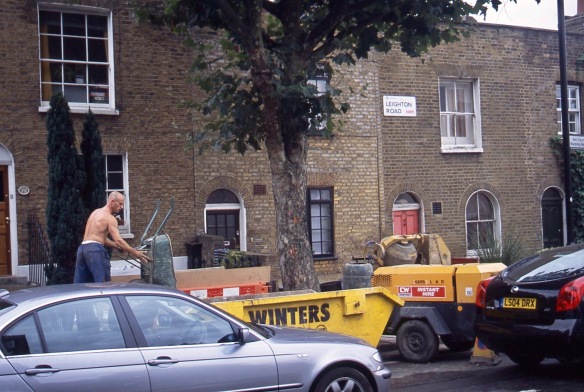CLICK ON IMAGES TO ENLARGE. REPEAT IF REQUIRED.
Here, at last, are the Streets of London colour slides from October 2004 that I scanned a couple of days ago.
Bravington Road, W9, in the heart of my Social Services patch, runs north from Harrow Road towards Queens Park. Here it is receiving the attentions of workers of the ubiquitous Clancy Group plc, described thus by Wikipedia:
‘Clancy Docwra is a large construction firm in the United Kingdom founded in Wembley in 1958 by Michael Clancy as M.J. Clancy & Sons Limited. In 1974 the firm bought water and gas public works contractor R.E. Docwra Limited and in 2001, following other acquisitions, all were merged to form Clancy Docwra Limited. Today the firm trades as The Clancy Group plc. The firm carries out work for several national utilities including Scottish Water and Scottish Power.[1] The firm has also carried out work for London Underground.’
Here, in Lancefield Street W10, are a pair of houses with gardens that, during my time there, were gradually built as part of a refurbishment of the notorious, prize-winning, Mozart Estate. Undoubtedly attractive in conception and design, the fatal flaw in these rabbit warrens was the number of convenient hiding places for muggers, and the lack of gardens in which residents could take pride. It was into the estate that two young men fled following their failed attempt to mug me a few years before.
Next door in Caird Street stands the Jubilee Sport Centre in which I spent many hours playing badminton and otherwise keeping fit, or knackering my knees, whichever way you look at it.
This corner of Enbrook Street, W10, shows one of the several rows of little Victorian terraced houses that had been demolished to make room for the Mozart Estate. Avenues numbered First to Sixth still contained these gems still being maintained.
When my friend, Norman, still lived in Harlesden, I would regularly walk along the streets mentioned above for one of our fortnightly lunches. I would vary my routes which could take me past The Roundwood Gospel Assembly building in Longstone Avenue NW10. On the other side of this road lies Roundwood Park, according to Wikipedia: ‘a public park in Willesden, London, measuring a total of 26.5 acres,[1] or approximately 10.27 hectares.[2] It was originally known in the 19th century as Knowles Hill (its name coming from the Knowles Tower nearby),[3][4] or Hunger Hill Common Field,[3][4] and after much work by Oliver Claude Robson, became the Roundwood Park known to the public today (its name coming from the Roundwood House originally beside it)’.
Following a dog-leg angle, the thoroghfare becomes Roundwood Road, on the corner of which this building is being adapted for more multiple occupation than the family home for which it was originally intended.
Oldfield Road, where Norman lived, received more than its share of graffiti.
At the time of these photographs, King’s Cross Bridge N1 was yet to form part of the extensive redevelopment of the area;
and Sheldon Square W2, was part of the Paddington Basin development nearing completion.
Now, what has caught the eye of this woman in Leighton Road, NW5?
Ah! I see.
Hang on a minute.
How did this one get in here?
The shadows must have attracted my attention while I was seeking street scenes. Let it stand. I think the lawn is in Rembrandt Gardens, Warwick Avenue, Little Venice.
This evening we dined on Jackie’s luscious lamb jafrezi with her perfect pilau rice. To accompany this, Jackie drank Hoegaarden, and I enjoyed a really marvellous Finca Flichman reserve malbec 2015 given to me for my birthday by Helen and Bill.











